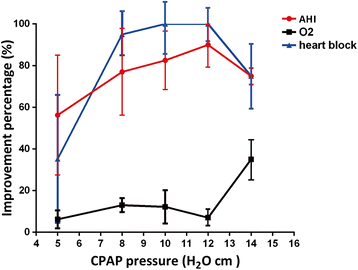Screening and managing obstructive sleep apnoea in nocturnal heart block patients: an observational study
- PMID: 26879052
- PMCID: PMC4754929
- DOI: 10.1186/s12931-016-0333-8
Screening and managing obstructive sleep apnoea in nocturnal heart block patients: an observational study
Abstract
Background: Nocturnal heart block often occurs in patients with obstructive sleep apnoea (OSA). It is more likely to be undiagnosed in heart block patients who are ignorant of the symptoms of sleep disorder. Berlin Questionnaire (BQ) is a highly reliable way to discover the risk factors of OSA, whereas the validity in sleep-related heart block patients is uncertain. We performed an observational study to address these issues and confirmed the potential protective effect of continuous positive airway pressure (CPAP).
Methods: Patients who were previously diagnosed with nocturnal heart block with R-R pauses exceeding 2 seconds were retrospective screened from the ECG centre of Zhongshan hospital. These recruited participants completed Berlin Questionnaire and underwent polysomnography synchronously with 24-hour Holter monitoring. A cross-sectional analysis was performed to confirm the association between nocturnal arrhythmia and OSA, as well as to assess the diagnostic accuracy of the BQ. Subsequently, subjects diagnosed with OSA (apnoea-hypopnoea index > 5) underwent 3 consecutive days of CPAP therapy. On the third day, patients repeated 24-hour Holter monitoring within the institution of CPAP.
Results: The symptoms of disruptive snoring and hypersomnolence in 72 enrolled patients were more related to the occurrence of nocturnal heart block (r = 0.306, 0.226, respectively, p = 0.015, 0.019) than syncope (r = 0.134, p = 0.282) and palpitations (r = 0.106, p = 0.119), which were prominent trait of our study population. The sensitivity, specificity, positive and negative predictive value of the BQ at a cut-off point of 5 of AHI for detecting OSA in heart block patients was 81.0 %, 44.4 %, 91.07 % and 25 %. Nocturnal heart block does not appear to occur exclusively in severe sleep apnoea. The frequent occurrence of arrhythmias in prominent oxygen desaturation supports the correlation between them. CPAP therapy resulted in significant decrease in the average number of episodes of heart block, from 148.58 ± 379.44 to 16.07 ± 58.52 (p < 0.05), same to the change of the longest RR pausing time (from 4.38 ± 2.95 s to 0.57 ± 1.05 s, p = 0.169) in 51 patients. The optimal therapy pressure to make the observed arrhythmia disappeared is 12 cm H2O.
Conclusion: Concerning high prevalence of OSA in heart block patients, BQ provided an economical and efficient screening method for OSA. For better management, CPAP therapy is feasible to prevent heart blocks avoiding unnecessary concomitant pacemaker implantation.
Figures


Similar articles
-
Combination of symptoms and oxygen desaturation index in predicting childhood obstructive sleep apnea.Int J Pediatr Otorhinolaryngol. 2013 Mar;77(3):365-71. doi: 10.1016/j.ijporl.2012.11.028. Epub 2012 Dec 14. Int J Pediatr Otorhinolaryngol. 2013. PMID: 23246417
-
Gastro-oesophageal reflux symptoms are related to the presence and severity of obstructive sleep apnoea.J Sleep Res. 2011 Mar;20(1 Pt 2):241-9. doi: 10.1111/j.1365-2869.2010.00843.x. J Sleep Res. 2011. PMID: 20545839
-
The STOP-Bang and Berlin questionnaires to identify obstructive sleep apnoea in Alzheimer's disease patients.Sleep Med. 2019 May;57:15-20. doi: 10.1016/j.sleep.2019.01.033. Epub 2019 Feb 8. Sleep Med. 2019. PMID: 30897451
-
Pre-operative screening for obstructive sleep apnoea.Eur Respir Rev. 2017 Jan 3;26(143):160012. doi: 10.1183/16000617.0012-2016. Print 2017 Jan. Eur Respir Rev. 2017. PMID: 28049125 Free PMC article. Review.
-
Diagnostic accuracy of screening questionnaires for obstructive sleep apnoea in adults in different clinical cohorts: a systematic review and meta-analysis.Sleep Breath. 2022 Sep;26(3):1053-1078. doi: 10.1007/s11325-021-02450-9. Epub 2021 Aug 18. Sleep Breath. 2022. PMID: 34406554 Free PMC article.
Cited by
-
Clues to the Pathophysiology of Sudden Cardiac Death in Obstructive Sleep Apnea.Cardiology. 2018;140(4):247-253. doi: 10.1159/000490308. Epub 2018 Sep 11. Cardiology. 2018. PMID: 30205374 Free PMC article. Review.
-
Investigate the relationship between obstructive sleep apnea and cardiac arrhythmia after CABG surgery.BMC Cardiovasc Disord. 2024 Jan 23;24(1):64. doi: 10.1186/s12872-023-03694-x. BMC Cardiovasc Disord. 2024. PMID: 38263001 Free PMC article.
-
The impact of continuous positive airway pressure on cardiac arrhythmias in patients with sleep apnea.J Res Med Sci. 2020 Apr 13;25:42. doi: 10.4103/jrms.JRMS_677_18. eCollection 2020. J Res Med Sci. 2020. PMID: 32582348 Free PMC article.
-
Obstructive Sleep Apnea: Women's Perspective.J Sleep Med Disord. 2016;3(6):1064. Epub 2016 Aug 25. J Sleep Med Disord. 2016. PMID: 28239685 Free PMC article.
-
Should the diagnosis and management of OSA move into general practice?Breathe (Sheff). 2016 Sep;12(3):243-247. doi: 10.1183/20734735.011216. Breathe (Sheff). 2016. PMID: 28210297 Free PMC article. Review.
References
Publication types
MeSH terms
LinkOut - more resources
Full Text Sources
Other Literature Sources

